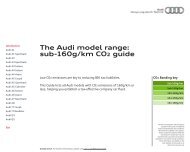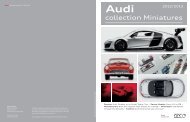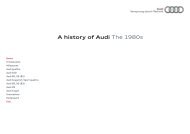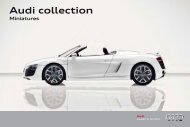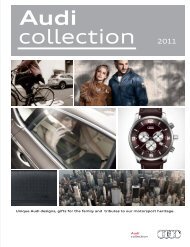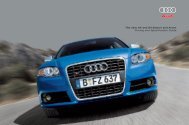The perfect Plecticle - Audi
The perfect Plecticle - Audi
The perfect Plecticle - Audi
Create successful ePaper yourself
Turn your PDF publications into a flip-book with our unique Google optimized e-Paper software.
Technology Pod<br />
Challenge 4<br />
D&T topic area: Resistant materials<br />
Students will learn how to:<br />
challenge their creative thinking<br />
sketch, draw and be imaginative in short bursts<br />
look at existing ways of travelling to extreme<br />
locations to collect materials and data.<br />
Differentiation<br />
Enrichment: Have available some draft<br />
examples of the challenge to inspire the<br />
class but encourage students not to copy<br />
the overall design.<br />
Intervention: Provide positive verbal<br />
feedback and encouragement at all times.<br />
STARTER<br />
In three minutes, ask students to list as many<br />
different modes of transport as possible, including<br />
vehicles that travel by land, sea and air. Which of<br />
these could be used by up to six people? If<br />
students could combine two of these modes of<br />
transport, which would they choose and why?<br />
TEACHING SEQUENCE<br />
Activity 1 – Exploring possibilities<br />
This exercise is designed to help focus students<br />
on the task at hand. Encourage students to use<br />
the internet, books or magazines to help<br />
conduct their initial research.<br />
Investigate current ways of achieving a similar,<br />
fast journey to the one in the challenge.<br />
Investigate existing super-strong materials and<br />
how students could improve them.<br />
Look at existing ways of providing comfortable<br />
and practical travel. You could encourage<br />
students to investigate space vehicles as they<br />
are forms of multi-task vehicles, but remind<br />
them that they are thinking about how this<br />
could be applied on earth and not in space.<br />
Vorsprung durch Technik<br />
TEACHER<br />
Activity 2 – Quick design exercise<br />
Ask students, in pairs, to consider these three<br />
extremes. Extreme Heat, Extreme Cold and Extreme<br />
Depth. Spend two minutes sketching three vehicles<br />
that could cope with each of these themes. Remind<br />
students that the function of the vehicle is just as<br />
important as the aesthetics. Students should then<br />
combine the three drawings.<br />
Activity 3 – Technology Pod challenge<br />
Introduce students to the Technology Pod challenge<br />
(see overleaf). This activity will offer students the<br />
opportunity to look at existing, modern transport<br />
designs as a means of inspiration and then combine<br />
the most effective elements of these to create a new<br />
product. To aid them in their design, encourage<br />
students to particularly consider existing transport<br />
methods used by scientists, which may include<br />
lorries, vans, helicopters, planes, hovercraft and even<br />
their own legs! Remind students that their design<br />
should be realistic as this has the potential to be<br />
developed in the near future.<br />
PLENARY<br />
A team of three students could complete this<br />
challenge. <strong>The</strong>re are three drawings to complete and<br />
an A4 sheet of explanations to create. All three<br />
students could design the outside of the craft and<br />
then split to provide the other parts of the challenge.<br />
Homework<br />
Complete the Technology Pod challenge.<br />
Main outcomes<br />
1. Using exemplar ideas to assist with designing.<br />
2. Reinforcement of sketching skills.<br />
3. Develop detailed criteria for designs and use<br />
these to explore design proposals.



